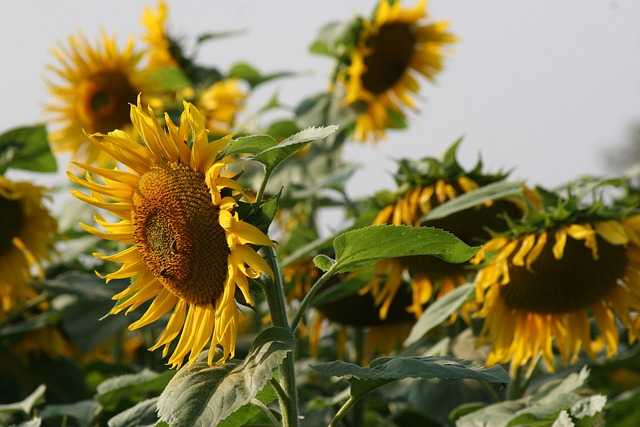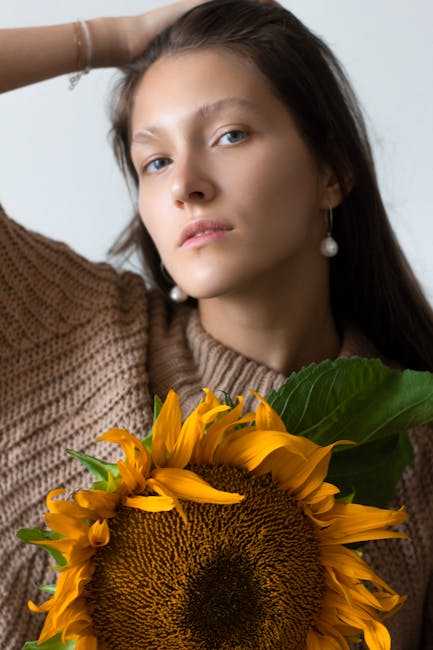Table of Contents
- Exploring the Symbolism and Meaning of Sunflowers in Art
- Techniques for Capturing the Vibrancy of Sunflower Paintings
- Choosing the Right Materials for Stunning Sunflower Art
- Inspiration from Famous Sunflower Artists and Their Works
- Q&A
- The Conclusion
Exploring the Symbolism and Meaning of Sunflowers in Art
Sunflowers, with their vibrant yellow petals and imposing stature, have long captivated artists and audiences alike. In art, they symbolize a myriad of virtues, including loyalty, adoration, and warmth. Their ability to mimic the sun’s brilliance and follow its path across the sky has led to associations with positivity and vitality. As a subject in painting, sunflowers have served as a powerful emblem of happiness, often depicted in full bloom to evoke feelings of joy and optimism.
Throughout history, artists have harnessed the sunflower’s potent symbolism to convey deeper meanings within their works. The famous series by Vincent van Gogh, for instance, showcases the flower not merely as a subject but as a statement of exuberance and life. The brush strokes, rich colors, and textures in his paintings bring forth an invitation to appreciate the beauty of everyday life, making the sunflower a bridge between the mundane and the sublime.
Moreover, the sunflower’s unique characteristics lend themselves to various interpretations across different cultures. In some traditions, the sunflower represents fertility and harvest, symbolizing abundance and prosperity. In others, it embodies faith and devotion, as the flower is known for its heliotropic nature—always turning toward the sun. This quality has led to its use in religious and spiritual contexts, where it touches upon themes of hope and guidance.
| Meaning | Symbolism | Culture |
|---|---|---|
| Joy | Happiness and Positivity | Western Art |
| Fertility | Abundance and Harvest | Agricultural Cultures |
| Faith | Guidance and Hope | Spiritual Traditions |
The enduring fascination with sunflowers in art continues to inspire contemporary creators across various media. From illustrations and photography to mixed media installations, artists today experiment with the essence of sunflowers—capturing their beauty while simultaneously exploring themes like transience and nature’s cycles. As they remain a significant symbol, sunflowers invite viewers to reflect on their personal connections to growth, resilience, and the joyful moments that life brings.


Techniques for Capturing the Vibrancy of Sunflower Paintings
To effectively capture the vibrant essence of sunflowers in your paintings, start by focusing on color theory. Sunflowers display an array of rich yellows, golden hues, and piercing greens that can evoke warmth and joy. Incorporating a bold palette is essential; consider using complementary colors to make the yellows pop. Here are some ideas:
- Cadmium Yellow for a bright, sun-kissed glow
- Burnt Umber to create depth in the petals
- Viridian Green for lush, vibrant leaves
Another essential technique is layering. By applying multiple layers of paint, you can develop depth and texture. Start with a base layer to lay down your primary colors, then gradually add highlights and shadows to enhance the flowers’ three-dimensionality. Experiment with glazing techniques to achieve a luminous effect that mimics the play of sunlight on the petals.
Additionally, consider texture creation using various tools. Palette knives, sponges, or even finger painting can add unexpected textures that bring your sunflower painting to life. Each tool interacts with the paint differently, allowing for dynamic and captivating effects. Here’s a quick comparison of techniques to explore:
| Technique | Description |
|---|---|
| Palette Knife | Creates sharp edges and thick textures. |
| Sponging | Adds soft, blended effects to the backdrop. |
| Impasto | Allows paint to stand out from the canvas. |
Lastly, don’t underestimate the power of composition. The arrangement of sunflowers in your piece should draw the viewer’s eye through the artwork. Utilize the rule of thirds to position your focal points effectively and incorporate negative space to enhance the overall balance of your painting. Consider experimenting with perspective by painting from above or below, providing a unique outlook that can make your sunflowers stand out.


Choosing the Right Materials for Stunning Sunflower Art
When embarking on a sunflower art painting project, the choice of materials can make all the difference in achieving a stunning result. Each material brings its own unique texture, color vibrancy, and finish, influencing both the creative process and the final artwork. Understanding the strengths of different materials allows artists to express their vision more vividly and tailored to their individual styles.
Acrylic paints are a popular choice for sunflower art due to their versatility and quick-drying properties. These paints allow for vibrant colors and a wide range of techniques, from thick impasto to delicate washes. When combined with canvas or wood panels, artists can create dynamic pieces that capture the bright essence of sunflowers. Additionally, using acrylic mediums can enhance the texture and sheen, offering endless creative possibilities.
For those who prefer a softer touch, oil paints offer a richness that can make the sunflowers appear almost luminescent. The slow drying time allows for more blending and layering, perfect for capturing the intricate details of sunflower petals. Pairing oil paints with canvas boards can deliver a professional feel and durability, ensuring the artwork stands the test of time.
Don’t overlook the importance of complementary materials such as brushes, palettes, and varnishes. Each element plays a role in the creative process and final presentation. Consider investing in a variety of brush shapes—like filbert and fan brushes—for different petal effects. Using a high-quality varnish can also protect your sunflower art, enhancing colors and ensuring longevity while providing a beautiful finish. Here’s a simple table summarizing the essential materials:
| Material | Benefits |
|---|---|
| Acrylic Paints | Vibrant color, quick drying |
| Oil Paints | Rich texture, slow drying |
| Canvas Boards | Durability, professional appearance |
| Brushes | Diverse effects, control |
| Varnish | Protection, enhancing finish |


Inspiration from Famous Sunflower Artists and Their Works
Sunflowers have long captivated the hearts and imaginations of artists, their vibrant yellows and dynamic forms lending themselves beautifully to various interpretations. Among the most notable sunflower artists is Vincent van Gogh, whose iconic series of sunflower paintings showcases his unique post-impressionistic style. Van Gogh’s vibrant brushwork and bold color choices not only capture the beauty of sunflowers but also convey deep emotional resonance. Each stroke reflects his fascination with nature and the transient beauty of life, making his sunflowers a timeless study in both form and feeling.
Another hallmark in the sunflower art world is Claude Monet, who, through his impressionist style, brought sunflowers to life with a seemingly effortless grace. Monet’s approach emphasized the natural light and atmospheric conditions that alter the perception of color and shape in sunflowers. His works invite viewers to step closer and appreciate the delicate interplay between shadow and light, transforming what could have been a simple flower study into an atmospheric experience that dances with color. Monet’s canvases serve as a reminder of how nature’s beauty can be reinterpreted through a lens of artistic perception.
Contemporary artists have also taken inspiration from sunflowers, infusing their own personal styles into this classic subject. For example, Yayoi Kusama incorporates her iconic polka dots into her sunflower-themed installations, merging modern art with the traditional sunflower image. Through her unique lens, Kusama emphasizes the sunflower’s innate qualities while attaching new meanings and experiences to the flower, thus expanding the narrative associated with it. This modern twist encourages current and future artists to see sunflowers not just as muses, but as multifaceted symbols that can evolve and adapt within contemporary art dialogues.
To explore the fascinating connection between sunflowers and artists throughout history, the following table highlights key artists, their notable works, and the unique perspectives they offered:
| Artist | Notable Work | Artistic Approach |
|---|---|---|
| Vincent van Gogh | Sunflowers (1888) | Post-Impressionism, bold colors and emotional depth |
| Claude Monet | Sunflowers (1881) | Impressionism, focus on light and atmosphere |
| Yayoi Kusama | Flowers (2015) | Contemporary, blending modern motifs with nature |
These artists exemplify the diverse interpretations and styles that can emerge when creating art inspired by sunflowers, showcasing their enduring appeal across different eras and artistic movements. Whether through traditional canvases or contemporary installations, the influence of sunflowers continues to flourish in the world of art.
